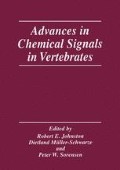Abstract
Eight purebred dogs, separated from their mother for 7’68 months (Median: 33) spent more time (p <. 02) reacting to her scent than to that of an unfamiliar, like-breed female, thus displaying scent-mediated kin recognition. Newborn dogs reared for sale are nurtured by human caretakers, thereby creating an enduring social bond. Consistent with this view, 9 purebred dogs separated from their caretaker for 11’39 months (Median: 13) spent more time (p <. 01) reacting to their caretaker’s scent than to that of a like-sex stranger living with a dog of the same breed and sex. The temporal limits of scent-mediated kin recognition and memory of their caretaker’s scent remain to be explored.
Access this chapter
Tax calculation will be finalised at checkout
Purchases are for personal use only
Preview
Unable to display preview. Download preview PDF.
References
Bekoff, M. 1993. The necessity and inevitability of social bonding between researchers and animals. Anim. Behav. Consult. Newsletter, 10(4) 1–2.
Colgan, P. 1983. Comparative Social Recognition. New York: John Wiley.
D’Amato, F.R. & Pavone, F. 1993. Endogenous opioids: a proximate reward mechanism for kin selection? Behav. & Neur. Biol., 60, 79–83.
Davis, S.F. & Ludvigson, H.W. 1995. Odor memory in nonhumans. In: Memory for Odors (Ed. by F.R. Schab & R.G. Crowder), pp. 133–157. Mahwah: Erlbaum.
Ginsburg, B.E. & Hiestand, L. 1992. Humanity’s “best friend”: the origins of our inevitable bond with dogs. In: The Inevitable Bond: Scientist-Animal Interactions (Ed. by H. Davis & D. Balfour), pp. 93–108. New York: Cambridge University Press.
Hepper, P.G. 1994. Long-term retention of kinship recognition established during infancy in the domestic dog. Special issue: individual and social recognition. Behav. Process. 33, (1–2), 3-14.
Johnston, R.E. & Jernigan, P. 1994. Golden hamsters recognize individuals, not just individual scents. Anim. Behav. 48, 129–136.
Leon, M. 1978. Filial responses to olfactory cues in the laboratory rat. Adv. Study Behav., 8, 117–153.
Leon M., Galef, B.G. Jr. & Behse, J.H. 1977. Establishment of pheromonal bonds and diet choice in young rats by odor pre-exposure. Physiol. & Behav., 18, 387–391.
Mekosh-Rosenbaum, V., Carr, W.J., Goodwin, J.L., Thomas, P.L., D’Ver, A. & Wysocki, C.J. 1994. Age-dependent responses to chemosensory cues mediating kin recognition in dogs (Canis familiaris). Physiol. & Behav., 55, 495–499.
Morell, V. 1997. The origin of dogs: running with the wolves. Science, 276, 1647–1648.
Panksepp J., Herman, B.H., Vilberg, T, Bishop, P. & DeEskinazi, F.G. 1980. Endogenous opioids and social behavior. Neurosci. & Biobehav. Rev., 4, 473–487.
Rosenblatt, J.S. 1983. Olfaction mediates developmental transition in the altricial newborn of selected species of mammals. Dev. Psychobiol., 16, 347–375.
Scott, J.R 1967. The development of social motivation. Nebr. Symp. Motiv. 15, 111–132.
Scott, J.P. 1992. The phenomenon of attachment in human-nonhuman relationships. In: The Inevitable Bond: Examining Scientist-Animal Interactions. (Ed. by H. Davis & D. Balfour), pp. 72–92. New York: Cambridge University Press.
Sherman, P.W. & Holmes, W.G. 1985. Kin recognition: issues and evidence. In: Experimental Behavioral Ecology (Ed. by B. Holldobler & M. Lindauer.), pp 437–460. New York: Verlag. 437-46
Vila, C, Savolainen, P., Maldonaldo, J.E., Amorim, I.R., Rice, J.E., Honeycutt, R.L., Crandall, K.A., Lundeberg, J., & Wayne, R.K. 1997. Multiple and ancient origins of the domestic dog. Science, 276, 1687–1689.
Wallace, P. 1977. Individual discrimination of humans by odor. Physiol. & Behav. 19, 577–579.
Author information
Authors and Affiliations
Editor information
Editors and Affiliations
Rights and permissions
Copyright information
© 1999 Springer Science+Business Media New York
About this chapter
Cite this chapter
Gillis, C., Legarsky, M., Lenker, L., Falkevitz, J., Carr, W.J. (1999). Scent-Mediated Kin Recognition and a Similar Type of Long-Term Olfactory Memory in Domestic Dogs (Canis Familiaris). In: Johnston, R.E., Müller-Schwarze, D., Sorensen, P.W. (eds) Advances in Chemical Signals in Vertebrates. Springer, Boston, MA. https://doi.org/10.1007/978-1-4615-4733-4_26
Download citation
DOI: https://doi.org/10.1007/978-1-4615-4733-4_26
Publisher Name: Springer, Boston, MA
Print ISBN: 978-1-4613-7145-8
Online ISBN: 978-1-4615-4733-4
eBook Packages: Springer Book Archive

